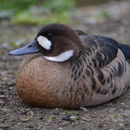Biology
provided by Arkive
This generally retiring species is typically found in pairs or small groups. It feeds on the seeds, leaves and stems of aquatic plants, but will also take some aquatic invertebrates, and feed on leaf litter in forests away from water. Breeding takes place form September to October, with egg-laying reaching a peak between October and November. The incubation period in captivity has been recorded to be around 30 days (2).
Conservation
provided by Arkive
At present there are no known conservation measures for the spectacled duck but significant populations of this species occur within several protected areas in both Chile and Argentina. Furthermore proposals have been made for further research into the potential threats this species faces from predation, tourism and fish farming (2).
Description
provided by Arkive
With its highly distinctive head and neck pattern, the spectacled duck is unmistakeable (3). From the neck up, this medium-sized dabbling duck is dark brown, except for conspicuous patches of pure white in front of the eye and extending from the throat around the neck (2) (3) (4). The upperparts of the body are generally dark chocolate brown, with light brown scalloping along the back, while underneath it is paler grey to light brown (2). An iridescent patch of purplish-bronze, known as the speculum, on each of the mainly black wings, gives rise to this species alternative common name (2) (3) (4). The sexes are similar in appearance, although the female is slightly duller, and the juveniles usually lack the distinctive white facial markings (3) (4).
Habitat
provided by Arkive
This species breeds mostly by rivers, fast-flowing streams and mountain lakes in densely wooded areas (2) (3) (4).
Range
provided by Arkive
The spectacled duck is most common in the Andean valleys of southern Chile and west-central Argentina, south as far as Tierra del Fuego (2) (3) (4).
Status
provided by Arkive
Classified as Near Threatened (NT) on the IUCN Red List (1).
Threats
provided by Arkive
Although the spectacled duck population is estimated at fewer than 10,000 individuals, there are no major threats to this species, and its numbers appear to be stable. There is however some concern that various factors, including predation by introduced American mink, increased tourism pressure, and salmon farming and trout stocking on Chilean rivers, could impact negatively on the spectacled duck population (2).

